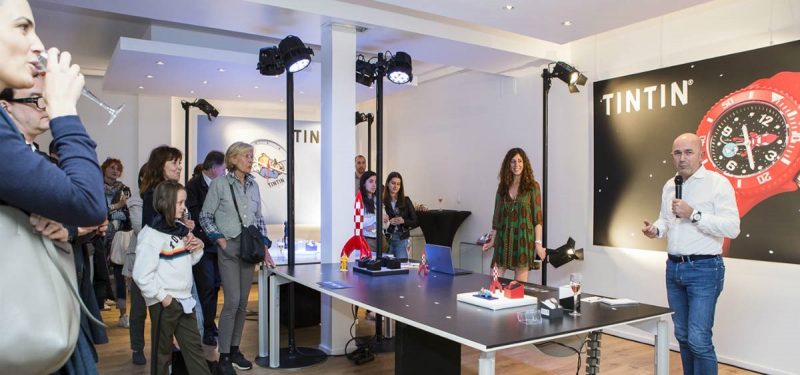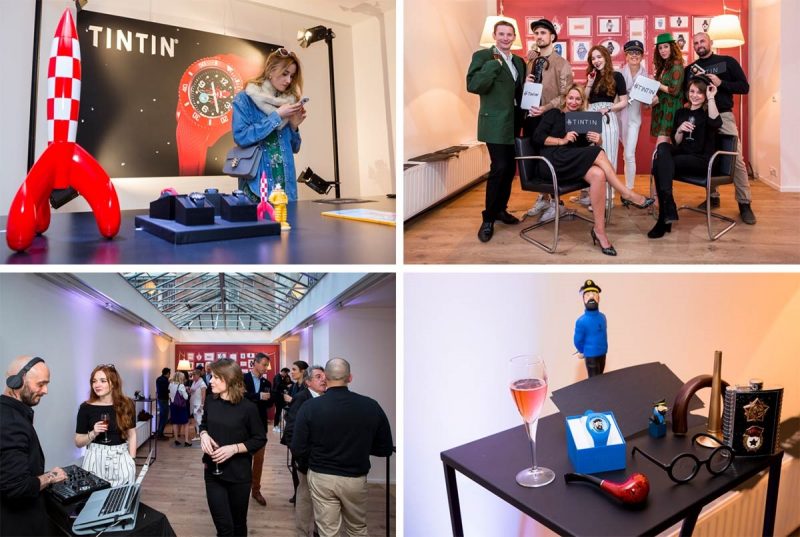
In June 2018, OneChocolate was “all hands on deck” for the launch of the Tintin timepiece collection at the Ice-Watch showroom in Paris.
A press event always requires planning and, given the challenges the client is facing and the amount of work it involves, it can appear overwhelming at times. So how do you appeal to as many journalists and influencers as possible? How do you set the right ambiance to create the perfect moment? In this post, we wanted to give you a series of tips that will help ensure the success of your press events!
-
Right place, right time
“Where should your event take place? Which day should you choose? What time is better-suited to ensure the best attendance?”
These are some of the first questions you should address. Indeed, finding the ideal location and the right date plays a significant role in the event’s success. Here are some ground rules you may want to follow:
- Always go for a central, easy-to-access location, whether it is your own office or a venue rental;
- Avoid holidays or non-working days;
- Avoid Mondays and Fridays as far as possible;
- Ask yourself which day may best fit your event – a non-school day if products destined to children are involved, so the journalists may bring their offspring along; or on the contrary, avoid non-school days if it has to do with products destined to mothers; etc.
You should bear in mind that these rules are not set in stone. Some of our most successful events did not abide by any of them! The most important thing is that your choices are aligned with your event’s objectives and the overall strategy of the message you want to send.
-
Know your target
If your event takes the form of a pop-up shop or an open-house day, timing is less crucial, since journalists may show up at any time during the day, depending on their availability.
Although, if you elected a shorter format, we advise you to make your corporate announcements during a press conference that takes place at breakfast or lunchtime – to which B2B journalists are more accustomed – whereas mainstream press journalists are keener on evening events (although keep in mind these should not extend too late!).
-
Surround yourself with the right people
One does not become caterer, graphist, or scenographer overnight. Here is our advice: for these aspects, hire professionals who – through their expertise – will contribute to the event’s success. Anticipate in order to find the perfect provider for each role, whose quality of service and rates match your vision for the event. These professionals may also contribute precious advice that may help simplify your work.
-
Make sure journalists show up
Once the invitations have been sent to your target media database, you will enter the unavoidable “reminder phase”. Journalists receive several hundreds of e-mails every day and there is a good chance that they did not see your invite – even if the subject is on point with what they are looking for! For this part, you should arm yourself with a phone and a quick, concise, pre-prepared vocal message (you will probably be talking to a few answering machines) and send invitations to your target database once again. Be patient and eventually, you will reap the benefits of your hard work!
-
Documentation and goodies for attendees
Remember to prepare and bring the documentation along with all the items journalists will be given during the event. As a general rule, it is easiest to hand out flash drives with a press kit attached that includes a press release, visuals, speakers’ bios, and all and any information and support documents related to the event. This will help journalists write a better article.
In addition to these flash drives, most companies also give out goodies. It is easy if you represent a product brand – you can offer each attendee a branded bag containing one or several product(s) (if it fits your budget, of course).
For a corporate announcement, journalists are usually offered a pen and notepad bearing the company logo. If you feel you have better, out-of-the-box ideas, you should not hesitate to go for it!
-
D-Day has come… don’t panic
Catering service: check.
Venue set-up: check.
…
If all providers and contributors have been thoroughly briefed (on the journalists’ arrival time, the event’s schedule, etc.) and if you allowed enough time between the venue set-up and the journalists’ arrival, there is no reason to panic. All will go well, because you will have some time to deal with the unexpected… which, whatever you do, always shows up uninvited😉! When the event starts, you should welcome the attendees by checking their names on a pre-printed list and then remain at disposal to answer any questions.

What happens after?
Even though the event itself is now over, there are still things to be done on the PR front. We drew up a short checklist for you:
- Send the press release to your whole target media database;
- … and of course, follow up on each journalist’s individual requests;
- Roll up attendees’ positive and negative feedback about the event and also their suggestions for improvement;
- Draw up a complete report including qualitative and quantitative outcomes;
- Compile all press fallout in an exhaustive press review.
You are now ready to organise your very own press event!
Alexandra Corbelli




